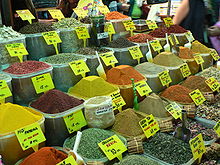|
|
|
Spices
Spices and herbs are used in many different ways in the art of cooking. Interestingly,
different cultures use different sets of spices and herbs to give the dishes their
distinguishing taste and flavour.
Whole spices compared to ground spices
Most spices and herbs are available in either a finely ground form for cooking or
in the raw form as a seed, nut, leaf, or tuber. Most of the time, the ground form
is required to properly flavor the dish. Generally, whole spices keep their flavor
longer than the ground spices. South Asian cuisines often use whole spices that
they roast freshly before grinding for use, maximising the flavors and aromas released
into the food.
Bay leaves are generally used in stews and soups and are almost always used whole.
Green spices compared to dried spices
Often, a recipe will require modifications if the fresh version is used because
the flavors do change in the drying process. Fresh herbs are nearly always better
than dried herbs, as some subtle aromatics are lost during drying. When substituted
in recipes, one part dried herbs are approximately equal to 3 parts fresh herbs.
For example, 1/3 tablespoon of dried basil is equal to about one tablespoon of chopped
fresh basil.
Differences
The difference between herbs and spices is that, if a leaf of a plant can be used
to add flavor or aroma to dishes, then it is an herb. If it is another part, like
the seed, fruit, berry, and bark, then it is a spice.
|













